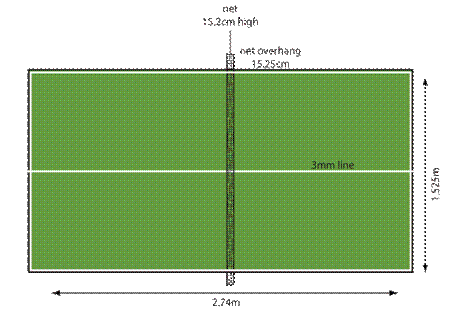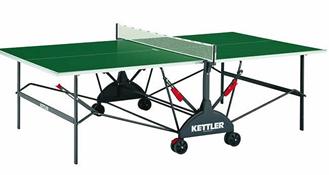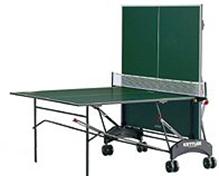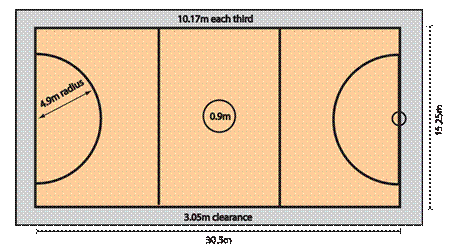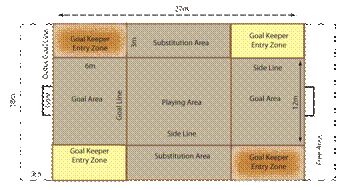
சமூக அபிவிருத்தித்திட்டம்
வல்வையில் நடைபெற வேண்டிய சமூக அபிவிருத்தித் திட்டங்களில் முதன்மையான ஒன்றாக பின்வரும் திட்டம் அமைகிறது. வல்வை.கொம் இல் நாம் தொடர்ந்து திட்டங்களை அறிமுகப்படுத்தி வருகிறோம். நீண்ட ஆராய்வுகளின் ஆலோசனைகளின் பின்னர்தான் திட்டங்களை பிரசுரிக்கிறோம். புலம்பெயர் வல்வை மக்களுக்கும் தாய்நில வல்வை மக்களுக்கும் மேலதிக விளக்கங்கள் தேவைப்படின் எம்முடன் தொடர்பு கொண்டால், நாம் உங்களின் சந்தேகங்களை தீர்த்துக்கொள்வோம்.
எம்மை பொறுத்தவரை பொருளாதார அபிவிருத்தியடைய வேண்டின் நாம் சமகாலத்தில் கல்வி அபிவிருத்தியையும் சமூக மற்றும் கலாச்சார அபிவிருத்தியையும் முன்னெடுத்துச்செல்ல வேண்டும். இல்லையெனில் தனியே எடுக்கும் எந்த அபிவிருத்தியும் முழுமையான பலனை தரமாட்டாது.
பல திட்டங்களை நாம் அறிமுகப்படுதியிருந்தோம், இத்திட்டங்கள் வல்வையின் எதிர்கால நன்மைக்காக போடப்பட்டவை. திட்டங்கள் அனைத்தும் அந்தந்த துறைகளில் பட்டறிவுள்ள, பொறியுணர்வுள்ள அனுபவசாலிகளின் ஆலோசனைகளுடன் பிரசுரிக்கப்பட்டுள்ளது.
சமூக அபிவிருத்தி திட்டங்களில் ஒன்றாக "பலவகைப்பட்ட திறந்தவெளி விளையாட்டு அரங்கம்/மையம்" ( Multi-Sports Arena/Centre) திட்டத்தை அறிமுகப்படுத்துகிறோம். இத்திட்டம் குட்டிமணியண்ணா சில மாதங்களுக்கு முன்னர் எமக்கு கூறியிருந்தார். விபரங்கள் கிழே வரும்.
Multi-Sports Arena/Centre பின்வரும் விளையாட்டுக்களை ஒரு அரங்கத்தில் அடங்க கூடியதாக இருக்கும்.
- Badminton
- Tennis
- Football (5-a-side, 6-a-side)
- Netball
- Volleyball
- Cricket (Indoor)
- Handball
- Archery
- Boxing
- Wrestling
- Judo
- Karate
- Taekwondo
- Weightlifting
- Table tennis
மேற்கூறிய விளையாட்டுக்கள் அனைத்தும் அதற்குரிய உபகரணங்களுடன் விளையாடலாம். இவ்வுபகரணங்களை வைப்பத்தட்கு ஒரு களஞ்சிய அறை தேவை.
மேற்கூறிய விளையாட்டுக்களுக்குரிய காட்சியரங்கக் கூடத்திற்குரிய அளவுகளும் பரிமாணங்களும் கீழே தரப்பட்டிருக்கிறது.
அதன் முன்பாக ஒரு சில உதாரணங்களாக சில படங்களை இணைத்துள்ளோம். வல்வையில் அமையப்போவது அந்த இடத்திற்கேட்ப வசதிகேற்ப அமைக்கப்படவேண்டும். கீழே தரப்பட்டிருப்பது உதாரணங்கள் மட்டுமே.
உங்களின் சிந்தனைகளுக்கு எட்டியவற்றை எமக்கு அறியத்தந்தால் அவற்றையும் நாம் இதனுடன் சேர்த்துக் கொள்வோம்.
.jpg)
.jpg)
.jpg)
.jpg)
.jpg)
.jpg)
.jpg)
.jpg)
.jpg)
.jpg)
.jpg)
.jpg)
.jpg)
.jpg)
.jpg)
.jpg)
.jpg)
.jpg)
.jpg)
.jpg)
.jpg)
.jpg)
.jpg)
.jpg)
.jpg)
.jpg)
.jpg)
.jpg)
.jpg)
.jpg)
.jpg)
.jpg)
.jpg)
.jpg)
மேலும் இவ்விளையாட்டுகளுக்கான நில பரிமாணங்களும் அளவுகளும் விளக்கங்களும் கீழே குறிப்பிடப்படுள்ளது.
Dimensions for Badminton
Badminton is an indoor racquet game played by one or two players opposing an equivalent number across a net.Court dimensions
The court is a rectangle and can be used for both singles and doubles. The court size for singles is 13.4m x 5.18m (playing area = 69.41m² including boundary lines) and 13.4m x 6.1m (playing area = 81.74m² including boundary lines). The lines are 40mm wide and coloured white or yellow. It is desirable to have a wooden sprung floor together with approved non-slip court mats.
Space about court
There is at least 2m clear space surrounding all the outer lines of the courts. There is also a minimum requirement of 2m between any two courts marked out side by side.
Posts and nets
Posts are 1.55m in height from the surface of the court. The net is 760mm in depth and a minimum of 6.1m wide. The top of the net from the surface of the court is 1.524m at the centre of the court and 1.55m over the sidelines for doubles. There is no gap between the end of the net and the post. If necessary, the full depth of the net at the ends is tied to the post.
Space over court
The minimum height from the floor over the full court for international competition is 12m. Club standard play is 9.14m. The required height is entirely free of all obstructions and light fittings over the area of the court.
Background and lighting
To avoid difficulty in sighting the shuttle, the background behind the ends of the court is not to be coloured white.
The minimum recommended lighting level is 1000 lux to provide even light over the court area. Lighting is not to be directly over or behind the playing area but positioned along the sides of the court. All sources of daylight or sunlight behind or along the sides of the courts are to be eliminated.
Shuttle testing marks
To test a shuttle a player uses a full underhand stroke which makes contact with the shuttle over the back boundary line. The shuttle is hit upwards at an angle and in a direction parallel to the sidelines. A shuttle of correct speed lands not less than 530mm and not more than 990mm short of the other back boundary lines as shown in the diagram below.
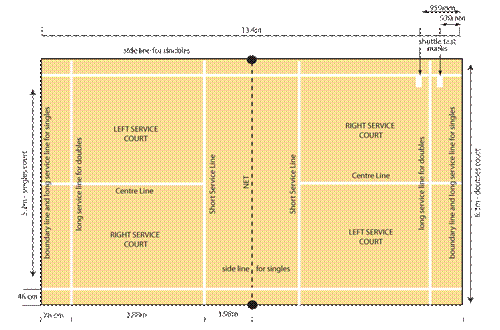
Dimensions for Tennis
Tennis is a game played between either two players (singles) or two teams of two players (doubles). Players use a stringed racquet to strike a hollow rubber ball covered with felt over a net into the opponent’s court so that they fail to return the ball.The court
The court is a rectangle, 23.77m long and for singles matches, 8.23m wide. For doubles matches, the court is 10.97m wide.
The court is divided across the middle by a net suspended by a cord or metal cable attached to two net posts 1.07m high. The net is fully extended and small enough mesh so a ball cannot pass through it. The height of the net is 0.914m at the centre, where it is held down tightly by a white strap. A white band covers the cord or metal cable and the top of the net.
For doubles matches, the net posts are 0.914m outside the doubles court on each side. For singles matches the centres of the net posts are 0.914m outside the singles court on each side.
Line markings
All court measurements are made to the outside of the lines and all lines of the court are the same colour clearly contrasting with the colour of the surface.
Baselines are lines at the ends of the court. Each baseline is divided in half by a centre mark, 10cm long and parallel with the singles sidelines. The baseline is up to 10cm wide.
Sidelines are the lines at the sides of the court.
Service lines are two lines between the singles sidelines 6.40m from each side of the net, parallel with the net.
The centre service line is on each side of the net.The area between the service line and the net is divided into two equal parts by the centre service line and is called the service courts. The centre service line is parallel with the singles sidelines and halfway between them. The centre service line and centre mark is 5cm wide.
Space around the court
For international competitions, the minimum distance between baselines and backstops is 6.4m. The minimum distance between side lines and sidestops is 3.66m.
For recreational and club play, the minimum distance between baselines and backstops is 5.48m. The minimum distance between sidelines and sidestops is 3.05m.
The minimum height to the ceiling is 9.14m for indoor tennis. Where courts are constructed within the confines of a common enclosure, the distance between sidelines is not less than 3.658m.
Court surfaces
There are several types of courts depending on the materials used for the court surface. Each playing surface has its own unique characteristics which affect the playing style of the game. The table below identifies generic court surfaces type and description as provided by the International Tennis Federations (ITF).
Type of surface |
|
Acrylic |
textured, pigmented, resin-bound coating |
Artificial clay |
synthetic surface with the appearance of clay |
Artificial grass |
synthetic surface with the appearance of natural grass |
Asphalt |
bitumen-bound aggregate |
Carpet |
textile of polymeric material supplied in rolls or sheets |
Clay |
unbound mineral aggregate |
Concrete |
cement-bound aggregate |
Grass |
natural grass |
Other |
modular systems (tiles), wood, canvas |
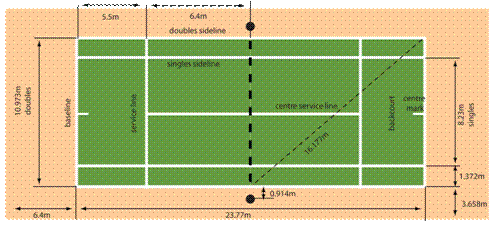
Lighting
The fundamental requirement of a tennis lighting installation is the control of the brightness of the ball and the background against which it is viewed. The ball must be visible regardless of its location and speed. The Australian Standard for outdoor tennis courts for recreational and residential is 250 lux, club competition and commercial 350 lux and national and international 1000 lux. It is recommended that floodlights be installed at a minimum of 6m for residential and recreational and 8m for club competition and above.
The following types of lighting systems are used for lighting outdoor tennis courts. Further technical information is available in Australian Standard 2560.2.1.
Lighting system |
Description |
Advantages |
Disadvantages |
Side lighting |
four or six poles adjacent to sides of the court |
less glare, lower poles, easier to control spill light |
pole locations if more than one court is to be lit |
Corner lighting |
only four luminaires are used situated at each corner of the court |
high level of illuminance on ball surface, suitable for two or more courts where limited room is available between courts |
glare from luminaires, higher poles, difficult to control spill light |
Hybrid lighting |
combination of side and corner lighting on a multi-court installation |
less glare, lower poles, easier to control spill light |
not suited to the use of side or corner lighting fittings |
Dimensions for Football — Soccer
Football, commonly known as soccer, is a team sport played between two teams of 11 players each. It is played on a rectangular grass field, with a goal at each end. With the exception of the two goal keepers, players may not handle the ball, but must propel the ball with their head or feet.
The object of the game is to score by manoeuvring the ball into the opposing goal. The team that scores the most goals by the end of the match wins. If the score is tied at the end of the game, either a draw is declared or the game goes into extra time and/or a penalty shoot-out, depending on the format of the competition.
Football 11-A-Side Dimensions for Football - Soccer
Official soccer field dimensions
The field of play is rectangular. The length of the sideline must be longer than the length of the goal line. Measurements are as follows:
- length ─ minimum 90m maximum 120m
- width ─ minimum 45m maximum 90m
International matches
- length ─ 105m
- width ─ 68m
It is recommended that there is a minimum 3m space around the pitch. In the interest of player safety it is advisable to increase this distance wherever possible.
Field markings
The field of play is marked with lines called boundaries. The two longer boundary lines are called touch lines. The two shorter lines are called goal lines. All lines are a maximum of 12cm wide. The field of play is divided into two halves by a halfway line. The centre mark is at the midpoint of the halfway line. A circle with a radius of 9.15m is marked around it.
Goals
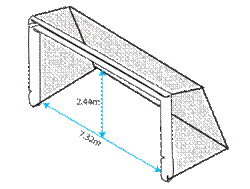 Goals are placed on the centre of each goal line. There are two upright posts equidistant from the corner flag posts and joined at the top by a horizontal crossbar. The distance between the posts is 7.32m and the distance from the lower edge of the crossbar to the ground is 2.44m. Both goal posts and the crossbar have the same width and depth, not exceeding 12cm. The goal lines are the same width as that of the goal posts and the crossbar. Nets can be attached to the goals and the ground behind the goal, provided that they are properly supported and do not interfere with the goalkeeper. The goal posts and crossbars must be white.
Goals are placed on the centre of each goal line. There are two upright posts equidistant from the corner flag posts and joined at the top by a horizontal crossbar. The distance between the posts is 7.32m and the distance from the lower edge of the crossbar to the ground is 2.44m. Both goal posts and the crossbar have the same width and depth, not exceeding 12cm. The goal lines are the same width as that of the goal posts and the crossbar. Nets can be attached to the goals and the ground behind the goal, provided that they are properly supported and do not interfere with the goalkeeper. The goal posts and crossbars must be white.
All goal posts are secured to the ground’s surface in accordance with the regulations as stipulated by the relevant authority or owner of the ground.
The goal area
A goal area is defined by two lines drawn at right angles to the goal line, 5.5m from the inside of each goal post. These lines extend into the field of play for a distance of 5.5m and are joined by a line drawn parallel with the goal line. The area bounded by these lines and the goal line is the goal area.
Penalty area
Two lines are drawn at right angles to the goal line, 16.5m from the inside of each goal post. The lines extend into the field of play for a distance 16.5m and joined by a line parallel with the goal line. The area bounded by these lines and the goal line is the penalty area.
Within each penalty area, a penalty mark is made 11m from the mid-point between and goal posts and equidistant to them. An arc of a circle with a radius of 9.15m from each penalty mark is drawn outside the penalty area.
Corner flags
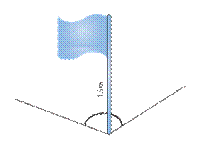 A flag post, minimum height 1.5m, with a non-pointed top and a flag is pl
A flag post, minimum height 1.5m, with a non-pointed top and a flag is pl
aced in each corner of the field. They are also placed at each end of the halfway line.
Corner arc
A quarter circle with a radius of 1m from each corner flag post is drawn inside the field of play.
Coaching and team areas
Team benches will be separated by a 9.15m neutral zone, and will be at least 3.05m from the touch line. The area will be marked parallel to the touch line and situated 3.05m from the touch line and extending 18.29m from the 5m neutral zone measured from the halfway line in both directions.
Lighting
The major elements influencing the visual tasks in soccer are the low to medium trajectory passes in all directions being common and scoring kicks always being low to medium trajectory. The space above the playing field is uniformly illuminated up to a height of approximately 15m. In order to meet the visual requirements of the goalkeeper in defending the goal area, some backlighting from a corner location is required.
Below are the recommended lux levels for soccer:
Ball, physical training |
Club competition, match practice |
Competition |
|
Amateur and semi-professional |
50 lux |
100 lux |
200 lux |
Professional |
100 lux |
200 lux |
500 lux |
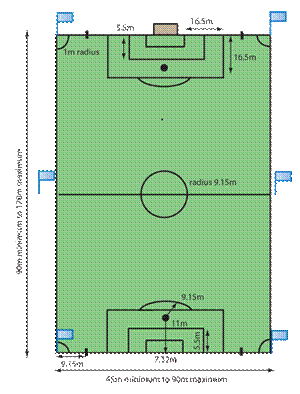
Futsal
Futsal is the only form of ‘indoor soccer’ or ‘five-a-side’ that is officially approved by FIFA and Football Federation Australia (FFA). It’s one of the fastest growing sports in the world, is played in over 100 countries and boasts millions of players around the world.
Pitch
The pitch surface is rectangular. At international level futsal is played either on a wooden or a synthetic floor that is smooth and flat and does not restrict the roll of the ball. At other levels futsal is played on a variety of surfaces including astroturf. Concrete or tarmac should be avoided.
Pitch markings
The pitch is marked with lines 8cm wide and divided into two halves by the halfway line. The centre mark is at the midpoint of the halfway line and marked with a circle with a radius of 3m. The two longer boundary lines are called touch lines. The two shorter ones are called goal lines.
The dimensions of a pitch are follows:
Minimum |
Maximum |
|
Length |
25m |
42m |
Width |
15m |
25m |
International matches |
||
Length |
38m |
42m |
Width |
18m |
25m |
Penalty area
The penalty area is marked by quarter circles with a 6m radius, drawn centred on the outside of each goal post. The quarter circles are drawn from the goal line to meet two imaginary lines 6m in length at right angles to the goal line from the outside of the goal post. The upper part of each quarter circle is joined by a 3.16m line running parallel to the goal line between the goal posts. The curved line marking the outer limit of the penalty area is the penalty area line.
The penalty mark is drawn 6m from the midpoint between the goal posts and equidistant from them. The second penalty mark is drawn on the pitch 10m from the midpoint betw
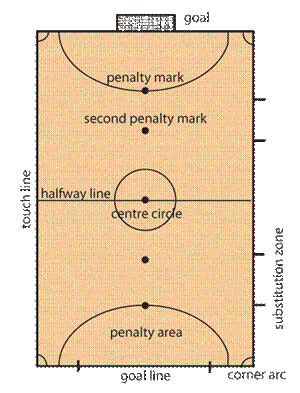 een the goal posts and equidistant from them.
een the goal posts and equidistant from them.
Corner arc
The corner arc is a quarter circle with a radius of 25cm from each corner and drawn on the pitch.
Substitution zones
The substitution zones are 5m in length and situated in front of the team benches. They are marked at each end by a line 8cm wide and 80cm in length, 40cm of which is drawn on the pitch and 40cm off the pitch.
The area in front of the timekeeper’s table, 5m to either side of halfway line, is kept clear.
Goals
The goals are placed in the middle of each goal line. They consist of two upright posts equidistant from each corner and joined at the top by a horizontal crossbar. The distance (inside measurement) between the posts is 3m and the distance from the lower edge of the crossbar to the ground is 2m.
The goal posts and crossbar have the same width and depth of 8cm. The goal lines are the same width as the goal posts and the crossbar. Nets made of hemp, jute or nylon are attached to the back of the goalposts and crossbar. The lower part of the net is attached to curved tubing or another means of support.
The depth of the goal is at least 80cm at the top and 100cm at ground level. The goals must have a stabilising system that prevents them from overturning. Portable goals may be used provided they are as stable as normal goals.
Small sided games (SSG)
SSG is the FFA’s modified game for children 6−12 years old. The aim is to give young girls and boys the maximum opportunity to participate in soccer. This program replaces Rooball, with the implementation to be complete by 2012.
This is all about ‘kids’ soccer’. Kids play on smaller fields with less players, fewer rules and modified equipment. As a result, they get more touches of the ball, more goals scored, increased activity and a lot more fun.
SSG is played on any field or open arena. The new age football program is divided into four age specific groups and games:
- Under 6 (Football 4s) ─ 4 v 4 games on micro fields, about an eighth of a full sized field
- Under 7−8s (Football 5s) ─ 5 v 5 games on mini fields just less than a quarter of an adult-sized playing field
- Under 9−10s (Football 7’s) ─ 7 v 7 games on macro fields about a quarter of the size of an adult field
- Under 11−12s (Football 9’s) ─ 9 v 9 on maxi fields about half an adult-sized field
Following are diagrams of the FFA’s suggested layouts for SSG football grounds using a full size adult soccer pitch - 120m long x 90m wide (maximum).
Football 4s: (players aged 5–6)
- Number of players ─ four field players plus two interchange players
- Field size ─ 30m x 20m
- Game time ─ 2 x 15 mins
- The ball ─ approved size 3 ball
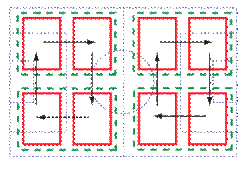
Football 5s: (players aged 7–8)
- Number of players ─ five field players plus three interchange players
- Field size ─ 30m x 20m
- Game time ─ 2 x 20 mins
- The ball ─ approved size 3 ball
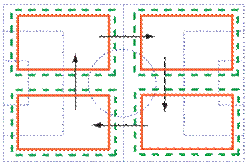
Football 7s: (players aged 9–10)
- Number of players ─ seven field players plus three interchange players
- Field size ─ 40m x 30m
- Game time ─ 2 x 25 mins
- The ball ─ approved size 4 ball
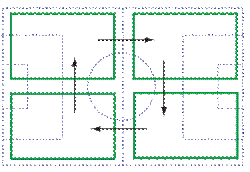
Football 9s: (players aged 11–12)
- Number of players ─ nine field players plus three interchange players
- Field size ─ 60m x 40m
- Game time ─ 2 x 30 mins
- The ball ─ approved size 4 ball
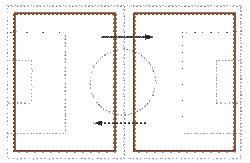
Dimensions for Netball
Netball is an international sport and played by two teams of seven players, based on throwing and catching. The object is to score goals from within a defined area by throwing a ball into a ring at one’s own end of the court.
Seniors
Netball is played on a firm surface, both indoor and outdoor. The court is divided into three equal parts ─ a centre third and two goal thirds measuring 10.17m each.
Court dimensions
- 30.5m long and 15.25m wide. The longer sides are called sidelines and the shorter sides are called goal lines
- The court is divided into three thirds measuring 10.17m each
- Centre circle is 0.9m in diameter in the centre of the court
- Goal circle is a semi-circle 4.9m in radius and its centre is the mid-point of the goal line
- Ceiling height — minimum of 8.3m
- Line markings — all lines are part of the court and no more than 50mm wide
- Gradient is one per cent cross fall in both direction
Run-off
There is a minimum run-off space of 3.05m outside each sideline. Other recommended run-off spaces are as follows:
- goal lines 3.05m
- to wall/seating 3.05m
- between courts 3.65m
Goal posts
- Post height is 3.05m and placed at the midpoint of each goal line
- Post diameter — standard 65mm. If padding is used on the goal post, it must not be more than 50mm thick and start at the base of the goal post and extend between 2m and 2.4m up the goal post
- Ring is 380mm internal diameter and made of a 15mm steel rod fitted with a net clearly visible and open at both ends. The ring extends 150mm from the top of the goal post
- Net is approximately 20mm steel mesh or white cotton mesh
- Post fixing (internal) — there are no struts from ring to goal post. The post is inserted in a socket in the ground or supported by a metal base that does not project onto the court
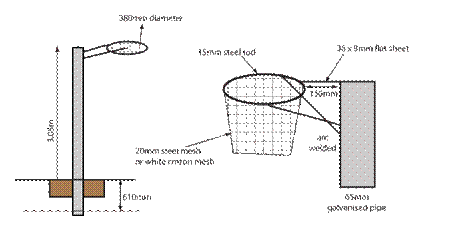
Lighting
In a netball game players move around the court in all directions and are required to look virtually in all directions, not only at eye level but also upwards. During play the ball may be thrown up to 8m high. The player must be able to follow the flight of the ball and actions of other players over the entire court area. Although the ball is large, action is fast and relatively high illuminances are required.
The minimum Australian Standard for indoor netball courts is 700 lux–800 lux. The minimum Australian Standard for outdoor netball courts is 100 lux for recreational or training level and 200 lux for competition level. Pole heights are from 8m to 12m.
Generally, a side lighting system is used for outdoor courts, whether they be in a single court or multi-court complex. Side lighting gives better control of spill light outside the playing area and is more economical for one or two courts. Corner lighting is not recommended because of unavoidable glare when shooting for goal.
Netball ─ NETTA
NETTA netball is the modified game of netball for 8–10 year old boys and girls. It is played on a standard netball court but the goal posts are 2.4m high. The players also use a smaller ball.
FUN NET
FUN NET is a play based motor skills program for 5–7 year olds. The emphasis is on the acquisition of basic motor skills, in a fun environment of games and activities. There is no organised competition structure and modified equipment is used.
Dimensions for Volleyball
The sport of volleyball has two disciplines ─ beach volleyball and indoor volleyball. Traditional six-a-side indoor volleyball is referred to as Olympic volleyball. Beach volleyball is played by two teams of two players on a sand court divided by a net, while Olympic volleyball is played on a hard court.
One team aims to deliver the ball over the net and to ‘ground’ it on their opponents’ court while preventing it from touching the floor on their own court. Both disciplines follow the same basic skills and the flow of play follows similar lines ─ one team serves and the other tries to win the rally with a pattern of dig, set, spike within the requisite three touches.
Olympic volleyball
Playing court
The playing court is rectangular, 18m long and 9m wide. The space around the court or ‘free zone’ is a minimum of 3m on all sides.
The ‘free playing space’ is above the playing area and must be free of any obstructions. This is a minimum height of 7m from the playing surface.
For official or Federation of International Volleyball (FIVB) competitions, the free zone is 5m from the sidelines and 8m from the end lines. The free playing space is 12.5m in height from the playing surface.
Court markings
All lines are 5cm wide and must be light in colour, different from the colour of the floor or any other lines.
Boundary lines are the two side lines and two endlines
Centre line divides the playing court into two equal courts of 9m x 9m each. This line extends beneath the net from sideline to sideline
On each court, the rear edge of the attack line is drawn 3m back from the middle of the centre line and marks the front zone
Net and posts
The net is 1m wide and 9.5m−10m long and is made of 10cm square, black mesh. The top of the net is 2.43m high for men and 2.24m for women. The height is measured from the centre of the playing court.
A flexible rod 1.8m long and 10mm in diameter called an antenna is fastened at the outside edge of each side band on the net. Antenna are placed on opposite sides of the net and are considered part of the net. Antenna laterally delimit the crossing space.
The posts supporting the net are 0.50m−1m outside the sidelines. They are 2.55m high. The posts are round and smooth, fixed to the ground without wires.
Lighting
With volleyball lighting a high degree of glare control is necessary because of the upward viewing. The luminaires are positioned away from the normal lines of sight. The minimum lux for recreation and training is 300 and for competition 500. For FIVB world and official competitions, the lighting on the playing area is 1000 lux−1500 lux measured at 1m above the surface of the playing area.
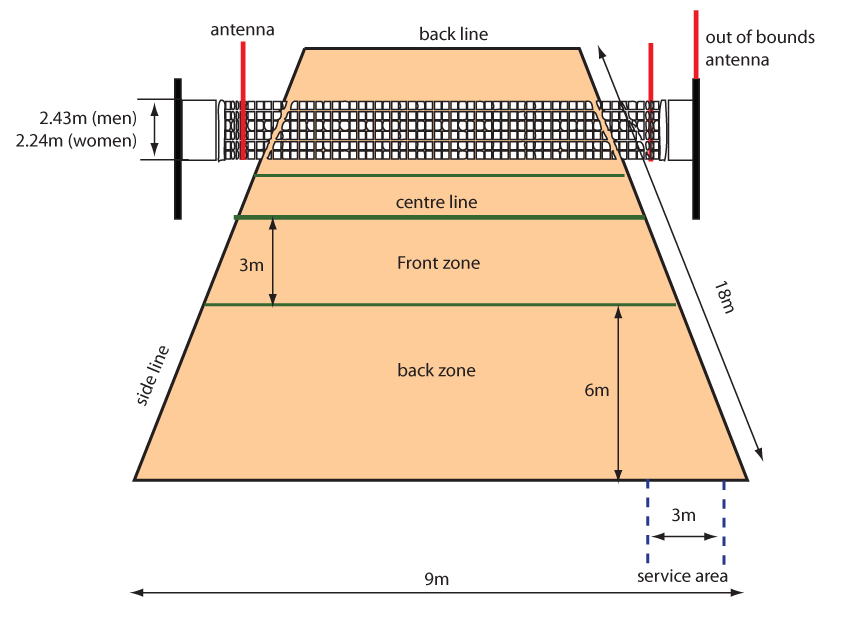
Beach volleyball
Playing court
The playing court is rectangular, 16m long by 8m wide. It is surrounded by a free zone a minimum of 3m wide and space free from obstruction up to a height of a minimum of 7m from the playing surface.
The terrain is levelled sand, flat and uniform as possible, free of rocks, shells and anything else to avoid risks of cuts or injuries to the players.
Two sidelines and two endlines mark the playing court. All lines are 5cm−8cm wide and are a colour that contrasts with the colour of the sand. There is no service area designated as players may serve from anywhere across the back line. There is no centre line.
The net
The net serves as a visible centre line of the court, dividing it into two halves. The net is 8.5m long and 1m wide when hung taut. It is 10cm square mesh. The height of the net is 2.43m for men and 2.24m for women. The posts supporting the net must be rounded and smooth, with a height of 2.55m, preferably adjustable. The posts must be padded.
Lighting
For official international competitions played during the night, the lighting is 1000 lux−1500 lux measured at 1m above the playing surface.
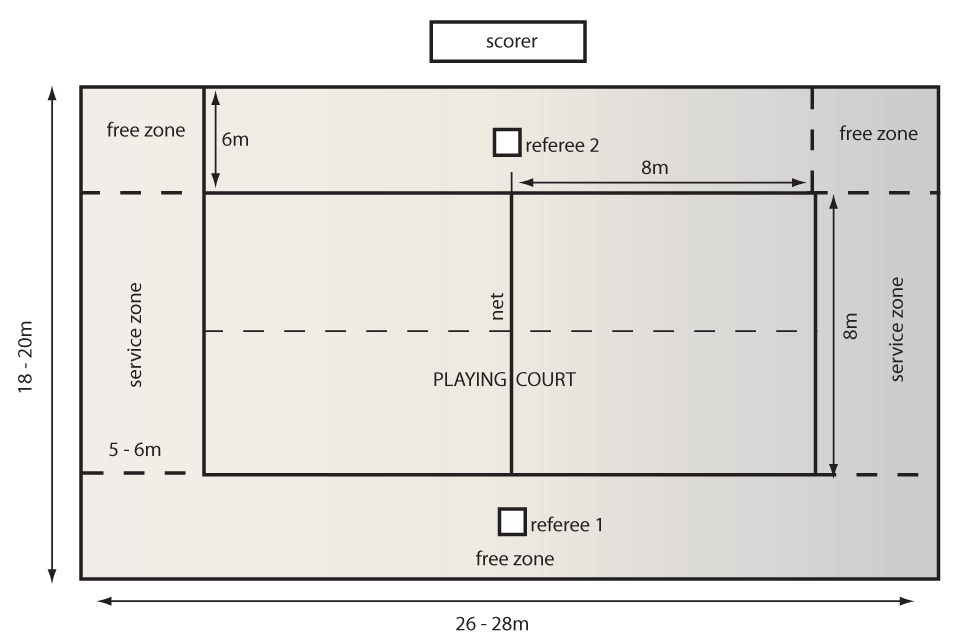
Dimensions for Cricket
Cricket is a high scoring bat and ball sport played between two teams, usually of 11 players each.
Outdoor cricket
Cricket is a high scoring bat and ball sport played between two teams, usually of 11 players each. A cricket match is played on an oval grass field, in the centre of which is a flat strip of ground called a pitch. At each end of the pitch is a set of three parallel wooden stakes (known as stumps) driven into the ground, with two small crosspieces (known as bails) laid on top of them. This wooden structure is called a wicket.
The pitch
A turf pitch is 20.12m long and 3.05m wide. A non-turf pitch is a minimum length of 17.68m and a minimum of 1.83m wide. A pitch is bounded at either end by the bowling creases and a set of wickets in the centre of the bowling crease.
In the case of a turf pitch, the slope of the pitch should not exceed 1 per cent and follow the slope pattern of the oval. If the oval is centre sloped, the pitch square should also slope from the centre.
The amount of fall should therefore not exceed 30mm across a 3.05m strip or 200mm along its length, being as flat as possible at the centre.
The pitch square should be about 75mm above the level of the outfield to allow for surface drainage off the pitch.
The bowling crease
The bowling crease is the line through the centre of the three stumps at the relevant end. It is 2.64m in length with stumps in the centre.
The popping crease
The popping crease is in front of and parallel to the bowling crease. It is 1.22m wide from the bowling crease. The popping crease is marked to a minimum of 1.83m on either side of the centre of the middle stumps and is unlimited in length.
The return crease
The return crease is at right angles to the popping crease at a distance of 1.32m either side from the middle of the stumps. The return crease is 2.44m behind the popping crease and unlimited in length.
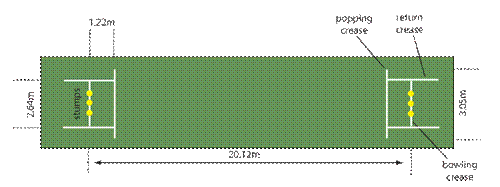
Cricket field
A cricket field is a large circular or oval shaped grassy ground. There are no fixed dimensions for the field but its diameter varies between 137m and 150m. On most grounds, a rope demarcates the perimeter of the field and is called the boundary.
Ideally, the oval should fall in all directions from the centre, but failing this, should have a single phase slope of one per cent in any convenient direction. If the oval is on a very well drained soil, no slope is required.
A painted oval is made by drawing a semi-circle of 27.4m radius from the centre of each wicket with respect to the breadth of the pitch and joining them with lines parallel, 27.4m to the length of the pitch. This line, commonly known as the circle, divides the field into an infield and outfield. Two circles of radius 13.7m centred on each wicket and often marked by dots, define the close-infield. The infield, outfield and the close-infield are used to enforce fielding restrictions.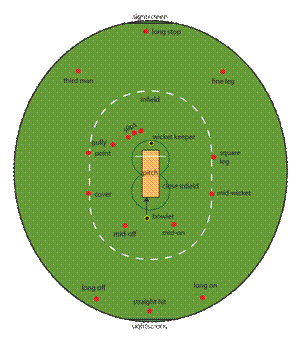
Lighting
The Australian Standard for lighting cricket grounds is as follows:
- non-televised training ─ 250 lux
- non-televised match ─ 500 to 700 lux
- televised match ─ 1400 lux
Modified outdoor cricket for juniors
The following table provides information on field and pitch dimensions for the various game formats in junior competition:
Game type |
Age group |
Boundary (measurement from centre of pitch) |
Pitch length |
In2cricket |
5-8 years |
25m-30m |
13m-16m |
In2cricket |
8-10 years |
Up to 40m |
13m-18m |
Dual pitch or 20/20 |
11-12 years |
40m-45m |
18m-20.12m |
1 day limited overs |
Under 13 |
50m maximum |
8m-20.12m |
1 day limited overs |
Under 14 |
50m maximum |
20.12m |
1 or 2 days limited overs |
Under 15 |
standard |
20.12m |
Super 8 cricket
Super 8 cricket is an introductory modified games program for upper primary school aged children.
Each team is allowed six to a maximum of 10 players. Only approved plastic equipment is used. The stumps are a single plastic mould with weighted base.
The pitch is 14m−16m long and can be any reasonably flat surface. The distance from pitch to boundary should not exceed 30m.
Indoor cricket
Indoor cricket is a variation of standard cricket. It was developed in Perth, Western Australia, in the late 1970s. It is suitable for cricketers and novices alike, and played year-round. Indoor cricket is played on a rectangular, artificial grass-surfaced court. The court is enclosed in tightly tensioned netting, including a 4m high ‘ceiling’.Courts are usually constructed in factory units or purpose-built centres.
A game is played with two teams, each with a maximum of eight players or, in some rare cases, six (though six-a-side centres are uncommon, they do exist ─ usually where the playing area isn’t big enough to construct a full-sized court). Indoor cricket uses a softer ball than a regulation cricket ball.
Playing area/net dimensions
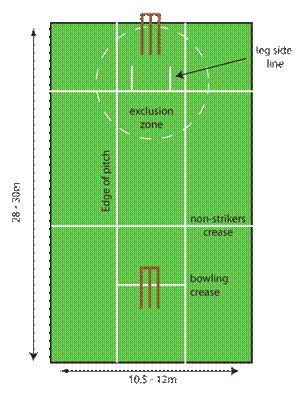 The court is rectangular, 28m−30m long, 10.5m−12m wide, and roofed by flat netting at 4m and 4.5m high. The walls are also of flexible netting. The cricket pitch is 20m long and 1.8m wide, covered with artificial turf, with the striker’s end close to one end of the court. An additional line is marked across the middle of the pitch, 11m from the striker’s popping crease, and forms the non-striker’s crease, behind which he is safe from being run out. The batsmen run only 11m to score runs instead of the full length of the pitch.
The court is rectangular, 28m−30m long, 10.5m−12m wide, and roofed by flat netting at 4m and 4.5m high. The walls are also of flexible netting. The cricket pitch is 20m long and 1.8m wide, covered with artificial turf, with the striker’s end close to one end of the court. An additional line is marked across the middle of the pitch, 11m from the striker’s popping crease, and forms the non-striker’s crease, behind which he is safe from being run out. The batsmen run only 11m to score runs instead of the full length of the pitch.
An ‘exclusion zone’ is marked in an arc extending at a radius of 3m from the batting crease. All lines are marked at a thickness of 5.5cm. The underarm line is marked across the pitch 7m from the striker’s stumps.
The wickets are 22.86cm wide, 71.1cm high and consist of three stumps with two bails 11.1cm long on top. The wickets are located at each end of the pitch 20m apart. The stumps are of equal and sufficient size to prevent the ball from passing through. Bails may be wooden or plastic and must be tied to the stumps.
The net
The net enclosing an indoor cricket court is very tightly tensioned. This allows consistency in the ball’s bounce off the net. It is also a safety feature — players are protected from hitting any walls or columns that may be close to the court and there is less chance of getting fingers caught in tight nets. It also allows spectators to be closer to the game, as players hitting the net will not stretch it far.
The court is defined by a cubic frame of high-strength steel cable, to which the netting is securely attached. Tensioning of the net is achieved by tensioning of this ‘cube’. The lower four cables of the cube are secured directly into the concrete floor. The four lower corners are tensioned to anchor points set into the concrete.
The top four cables are all fastened at the corners to anchor points, located on the ceiling/inner-roof. These take the main tension and help form the ‘box’ structure of the cables. These top cables are then further fastened to the ceiling for additional support. The shape of the box thus formed is achieved by adjusting the tension mainly in the eight corners, with finer tuning possible by individually adjusting the extra attachments along the top edges.
Lighting
It is essential to have good quality lighting so that the players can follow the movement of the ball travelling at high speeds, either struck by the batsman or bowled by the bowler. The illuminance must be uniform throughout the hall, with the background walls behind both batsman and bowler providing a good viewing contrast. Safety is paramount and the lighting system must taken into account the propulsion of balls at speed. The recommended minimum lighting level for an indoor cricket sports centre is between 1000 and1500 lux. These requirements are generally met by a system of horizontal, fluorescent luminaires, fitted with reflectors and mounted at right angles to the pitch. The reflectors must screen both batsman and bowler from direct view of this light source.
Dimensions for Handball
Handball is a fast-paced game involving two teams of seven players who pass, throw, catch and dribble a small ball with their hands while trying to score goals. The team with the most goals wins the game. A game consists of two 30-minute halves with a 10-minute half-time break.
Handball — indoor
Playing area
The playing court is rectangular measuring 40m x 20m. The safety zone surrounding the court has a minimum width of at least 1m along the sidelines and 2m behind the goal lines. The playing court is marked with lines 5cm wide except for the goal lines (between the goal posts) that are 8cm wide.
Goals
The goal is placed in the centre of each outer goal line and firmly attached to the floor or wall behind the goals. The interior measures 3m in width and 2m in height. The rear side of the goal post is in line with the goal line.
The goal area in front of the goals is a 3m x 6m rectangle and two connecting quarter circle sectors, each with a radius of 6m.
Lines
All lines are 5cm wide except for the goal lines which are 8cm wide. Other measurements are as follows:
- broken free throw lines are parallel and concentric to the goal area line with a 3m larger distance from the goal line. Segments and spaces between them are 15cm
- the 7m line is 1m long directly in front of the goal, parallel to the goal line, 7m from the rear edge of the goal line
- the goalkeeper’s restraining line is 15cm long directly in front of the goal. It is parallel to, and 4m away from, the goal line
- centre line connects midpoints of two side lines
- substitution line is 4.5m from centre line outside the boundary
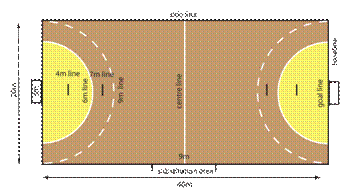
Handball — beach
The playing court is a 27m long by 12m wide rectangle with a playing area and two goal areas. The surface of the playing court is sand that is at least 40cm deep. There is a 3m safety zone surrounding the playing court.
The playing area is 15m long by 12m wide. Boundary lines are marked by a plastic, coloured bank or rope, with a width up to 8cm.
The goals are 3m wide by 2m high and firmly anchored in the sand. The goals must have a net. The goal area is marked by a band or rope attached parallel to the goal line and 6m away from it.
The substitution area is 15m long and 3m wide located on each side the playing area outside the sidelines.
Mini handball
Mini handball is adapted for children up to 8−9 years. They play on smaller playing areas, with smaller goals and ball and with rules the children are able to understand. Normal handball rules are the basis of mini handball, but the rules about technical faults are assessed according to the ages and the skills of the children participating in the game.
Dimensions for Archery
Archery is the art of shooting arrows from a bow at a target.
Although it is essentially an individual pursuit, it is possible to participate as a member of a team. Competitions in the sport of archery are classified in the following disciplines:
- outdoor target archery
- indoor target archery
- field archery
- clout archery
- flight archery
Outdoor target archery
Target archery is the most popular form of archery practised worldwide. Target archery events are called rounds and these consist of a number of ends at different distances from 30m to 90m.
The target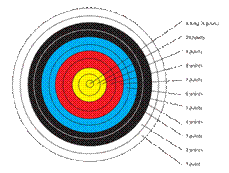
In outdoor target archery individual competition, athletes shoot 36 arrows at each of the following distances:
Men: 90, 70, 50 and 30 metres
Women: 70, 60, 50 and 30 metres
In the teams event, each team member shoots 24 errors per end. The target is 122cm at 70m for both men and women.
Outdoor target archery uses coloured targets which are either 122cm or 80cm in diameter. A 122cm target face is used for distances at 90m, 70m and 60m. The 80cm target face is used for distances at 50m and 30m.
Target faces have five colours with each colour being divided into two to provide 10 scoring zones. The innermost ring is given a value of 10 points, down to the outermost ring a value of 1 point. The X ring, worth 10 points, is used to break ties.
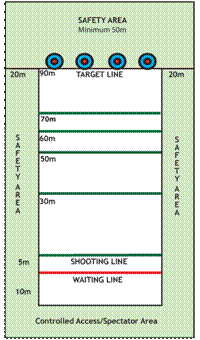
The target face is attached to a wooden stand (butt) with the centre 130cm above the ground. The target butt is also angled back about 10° off vertical.
The range
The ideal archery range consists of a level area of closely cropped grass in a reasonably sheltered position. The ground is laid out in a north–south axis with the shooting direction southerly. If a backstop and/or fence are not available there must be a cleared area of not less then 50m behind the longest target. This area is fenced or sign posted to prevent vehicle or pedestrian access.
There is a clear zone of not less than 20m either side of the field of play. This area is suitably fenced and/or sign posted.
Archers stand astride a clearly defined shooting line, 5m in front of the waiting and equipment line. A spectator line is located a minimum of 10m behind the waiting and equipment line.
Indoor target archery
Indoor target archery is an international discipline shot at 18m or 25m. Targets used for indoor competitions are identical to those used in outdoor target archery competitions. Archers shoot at 25m on a 60cm target and 18m at a 40cm target. The centre face of the target is 1.3m above the floor.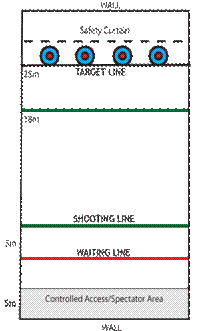
Lanes may be marked on the floor to accommodate two to four archers. The waiting line is at least 3m behind the shooting line.
Lighting
Fluorescent overhead light fixtures are recommended because of the uniform illumination and lack of harsh shadows.
Flight archery
Flight archery is the only discipline that does not involve a target — the sole object is reaching great distances.
The flight shooting field is an open, flat area. The landing area is at least 200m wide and up to 1km long. The grass must be short enough to allow arrows to be seen. The area is to be free of hazards such as trees, buildings, fences, ditches etc.
A 20m long shooting line is marked on the ground and 1m in front of this is the foul line. An area 20m long by 5m wide is roped off behind the shooting line and is used as the equipment area. A central line is marked on the ground from the minimum distance that will be shot, to 100m beyond the furthest distance expected to be recorded. Stakes are to be placed at nominal 100m intervals along the central line and appropriately labelled.
Field archery
Field archery is an outdoor discipline in which the archer takes on the terrain as well as the target. Field archery is a combination of archery, golf and bush walking. A course is set up in a bushland setting including hills, slopes, angles, light and shade.
A field course is made up either 24 or 28 targets. The archer is required to shoot either three or four arrows at each target. Distances range from 10m to 60m and target faces vary from 20cm to 80cm.
Clout archery
Clout archery is another popular discipline in Australia because of its fun aspect. Clout archery is shot over distances up to 180m, depending upon equipment used. A target measuring 15m in diameter is marked on the ground with a triangular marker or ‘clout’ placed at its centre. Archers shoot their arrows in the air attempting to land the arrows in the target.
The various scoring areas are marked with small coloured flags. These flags are located at each side of the clout flag in a straight line, at right angles to the direction of shooting and at 1.5m spacings. The flags relative to the target centre are coloured yellow, red, pale blue, black and white respectively.

Dimensions for Boxing
Boxing is a sport in which two participants of similar weight fight each other with their fists in gloves in a series of one-to-three-minute intervals called ‘rounds’. The bout takes place in a roped area called a ring.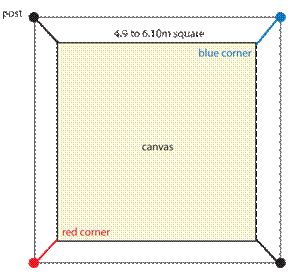
The ring
The minimum size is 4.9m² and the maximum size 6.10m² measured inside the line of the ropes. The ring is not less than 91cm or more than 1.22m above the ground or base. A minimum of 2m must be allowed for around the ring.
Platform and corner pads
The platform is level and extends for at least 46cm outside the line of the ropes. It is fitted with four padded corner posts as follows:
- red — in the nearer left-side ring corner facing the President of the Jury
- white — in the far left-side corner
- blue — far right-side corner
- white — near right corner.
Floor covering
The floor is covered with felt, rubber or other suitable approved material which covers the entire platform.
Ropes
There are three ropes 3cm−5cm thick, tightly drawn from corner posts at 40cm, 80cm and 130cm high. For four ropes, they are 40.6cm, 71.1cm, 101.6cm and 132cm high. The ropes are covered in a soft or smooth material.
Lighting
Recommended lux for recreation and training is 500 and for competition is 1000.
Layout of ropes in a boxing ring
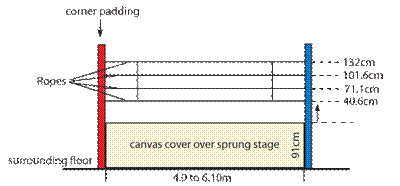
Dimensions for Wrestling
Wrestling is one of the oldest sports in the world. Origins of wrestling can be traced back thousands of years through depictions in cave drawings in France and Egyptian murals. It is practiced in nearly every country. The two main styles that are showcased in the Olympic Games are Greco-Roman and freestyle.
Greco-Roman wrestling allows competitors to use only their arms to 'attack' the upper bodies of their opponents. Freestyle wrestling allows competitors to use their arms and legs to perform holds on the whole body of their opponents. A wrestling bout comprises three two-minute periods, with a 30 second break. Wrestlers are awarded points from officials for technical manoeuvres against their opponent. The wrestler with the most points wins the bout.
The mat
The mat has a 1m central circle where the wrestlers begin from a standing position. The centre wrestling area is 7m in diameter and surrounded by a 1m wide passivity zone marked in red. The mat extends for another 1.5m. This area is known as the protection zone. This is the out-of-bounds area and if the wrestler throws his opponent into this area he can still score points before resuming back in the centre. It is also recommended to allow 2m on opposite sides of the mat for officials.
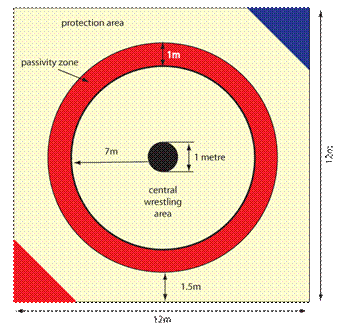 To prevent contamination, the mat must be washed and disinfected before every wrestling session. When mats that have a smooth, uniform and non-abrasive surface are used (canvas included), the same hygienic measures must also be applied.
To prevent contamination, the mat must be washed and disinfected before every wrestling session. When mats that have a smooth, uniform and non-abrasive surface are used (canvas included), the same hygienic measures must also be applied.
The diagonally opposite corners of the mat are marked out in the wrestlers’ colours, red and blue.
Lighting
The lighting requirements for wrestling is similar to martial arts. The Australian Standard for recreation and training is 500 lux and for competition is 1000 lux. Attention is given to the illuminance values in the vertical planes.
Dimensions for Judo
Judo means 'the gentle way' in Japanese. The moral code of judo is politeness, courage and sincerity. Judo is a combat sport that demands both physical prowess and great mental discipline.
From a standing position, it involves techniques that allow you to lift and throw your opponents onto their backs. On the ground, it includes techniques that allow you to pin your opponents down to the ground, control them and apply various choke holds or joint locks until submission.
Competition area
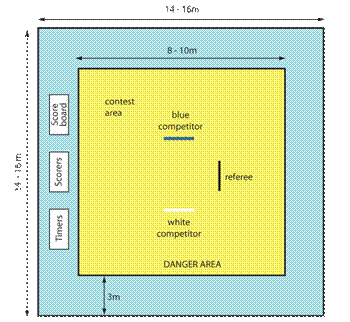 The competition area is a minimum of 14m x 14m and a maximum of 16m x 16m and is covered by tatamis or similarly acceptable green material. The competition area is divided into two zones. The contest area is a minimum of 8m x 8m or a maximum of 10m x 10m. Surrounding the contest area is a 1m wide danger zone. The safety area outside the danger zone is 3m wide.
The competition area is a minimum of 14m x 14m and a maximum of 16m x 16m and is covered by tatamis or similarly acceptable green material. The competition area is divided into two zones. The contest area is a minimum of 8m x 8m or a maximum of 10m x 10m. Surrounding the contest area is a 1m wide danger zone. The safety area outside the danger zone is 3m wide.
The competition area must be fixed to a resilient floor or platform. Where two or more adjoining competition areas are used, a common safety area of between 3m and 4m is necessary. A free zone of 50cm must be maintained around the competition area.
A strip of blue and a strip of white adhesive tape, 10cm wide and 50cm long, are fixed on the centre of the contest area 4m apart. This is the starting position at which the contestants must start and end the contest. The blue tape is fixed to the referee’s right and the white to his left.
Lighting
For all national and international competition under the International Judo Sports and Organisation Rules, lighting is a minimum 1500 lux up to 1800 lux. This is directed onto the competition area from the top, in such a way that no shadows are caused and not from the sides or from an oblique angle. It must not handicap the activities of the competitors, officials and spectators.
The Australian Standard for martial arts is 500 lux recreation and training and 1000 lux for competition. Attention must be given to provision of adequate illuminance values in vertical planes.
Dimensions for Karate
Karate (kara meaning empty and te meaning hand) is a martial art whose protocols and technical language have emanated from ancient Japan. Its wide spectrum of techniques include a myriad of blocks, strikes, kicks, evasions and throws.
Competition area
The competition area must be flat and devoid of hazard.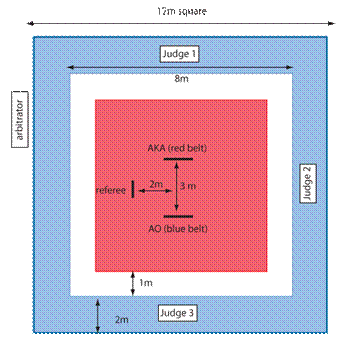
The competition area is a matted 8m square, with an additional 2m on all sides as a safety area.
A line half a metre long is drawn 2m from the centre of the competition area for positioning the referee.
Two parallel lines 1m long and at right angles to the referee’s line is drawn at a distance 1.5m from the centre of the competition area for positioning the competitors.
The judges are seated in the safety area, one directly facing the referee and one behind each of the fighters, 1m towards the referee. Each has a red and a blue flag.
The arbitrator is seated at a small table just outside the safety area, behind and to the left of the referee. He is equipped with a red flag or sign and a buzzer.
The score-supervisor is seated at the official score table between the scorekeeper and the timekeeper.
The 1m border is a different colour from the rest of the matted area.
The contestant wearing a red belt is referred to as AKA and the contestant wearing a blue belt is referred to as AO.
Dimensions for Taekwondo
Taekwondo literally means 'the way of hand and foot' or, more specifically, 'the way of kicking and punching'. Taekwondo is a combat sport originating in Korea and is now one of the most widely practiced martial arts in the world. It is the national sport of Korea and is an Olympic sporting event.
There are two types of sporting categories:
Kyorugi (sparring sport category)
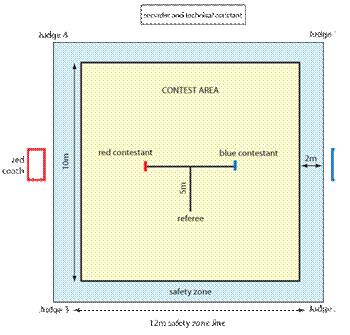 There are two players in a bout which is controlled by a referee. The players are matched according to age group, belt ranking, gender and weight. Contestants wear different coloured ‘tobok’ or uniforms. Points are scored when a player delivers a successful punch or a kick to designated target areas on the trunks and kicks to the head. There are four judges positioned in each corner of the contest area, with a 1m safety zone surrounding. Compulsory protective guards are used on the head, body, arms, hands, groin, legs, feet and mouth.
There are two players in a bout which is controlled by a referee. The players are matched according to age group, belt ranking, gender and weight. Contestants wear different coloured ‘tobok’ or uniforms. Points are scored when a player delivers a successful punch or a kick to designated target areas on the trunks and kicks to the head. There are four judges positioned in each corner of the contest area, with a 1m safety zone surrounding. Compulsory protective guards are used on the head, body, arms, hands, groin, legs, feet and mouth.
The duration of the contest is two rounds of two minutes each for lower rank belt divisions and three rounds of two minutes each for higher ranked black belt players. There is a one-minute rest period between rounds.
The competition area measures 10m x 10m and is covered with an EVA mat 20mm thick. The marginal line of the competition area is called the boundary line. The competition area may be installed on a platform 50cm−60cm high from the base and the outer part of the boundary line is inclined with a gradient of less than 30 degrees for the safety of the contestants. The safety zone area is 2m outside the boundary line.
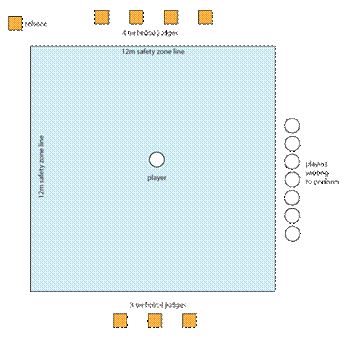
Poomsaie (technical sport category)
In this technical competition, each player individually performs a pre-determined taekwondo form that comprises taekwondo tehcniques using hand and feet techniques such as punching, blocking and kicking. Each form ranges from 40−60 moves.
The players are matched according to age group, belt ranking and gender. Other categories include individual, pairs, teams and creative poomsaie (with music and without music).
The competition floor area is a 12m x 12m EVA mat 20mm thick. There are seven judges, four on one side of the competition area and three on the other.
Dimensions for Weightlifting
Weightlifting requires a combination of power, speed, technique, concentration and timing. It is a sport in which competitors attempt to lift heavy weights mounted on steel bars called barbells.
The two main events are the snatch, in which the barbell is lifted from the floor to arm’s length overhead in a single, continuous motion, and the clean and jerk, in which it is lifted first to the shoulders and then, after a pause, to arm’s length overhead. All lifts must be executed on a competition platform.
Competition platform
The platform is a 4m square. If the floor surrounding the platform is the same or similar colour, the top edge of the platform must have a different coloured line of at least 150mm. The platform is made of wood, plastic or any solid material and can be covered with a non-slippery material.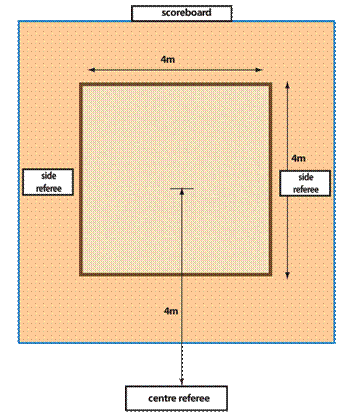
A clear 1m area surrounding the platform is compulsory. This area must be flat and free from any obstacle including discs.
Weightlifting competition area
The height of the platform is between 50mm and 150mm. If the platform is above ground level, a restraining bar at least the width of the platform is suitably and safely fixed to the stage, at least 1m in front of the platform.
Where a prescribed platform is not available the competition may be conducted within a 4m square marked clearly on the floor. In this case the athlete is only regarded as leaving the platform if during the execution of the lift the athlete’s feet completely leave the marked area.
The centre referee must be seated 4m away (measured from the front of the platform to the rear of the referee’s table) and in line with its centre. The side referees must be seated on the same line as the centre referee, 3m−4m apart.
Dimensions for Table tennis
Table tennis is a sport in which two or four players hit a lightweight, hollow ball back and forth to each other with bats (called racquets or paddles). The game takes place on a table divided by a net.
Players must allow a ball played towards them to bounce only once on their side of the table and must return it so that it bounces on the opponent’s side. The object is to win points by making shots that an opponent is unable to return.
Playing table and area
The table is 2.74m long, 1.525m wide and 76cm high with a masonite or similarly manufactured timber, layered with a smooth, low-friction coating. The table or playing surface is divided into two halves by a 15.2cm high net. The playing space around the table must be at least 14m long, 7m wide and 5m high.
Lighting
The light intensity, measured at the height of the playing surface, is at least 600 lux uniformly over the playing surface and at least 400 lux elsewhere in the playing area. The light source shall not be less than 5m above the floor.
